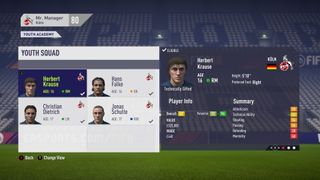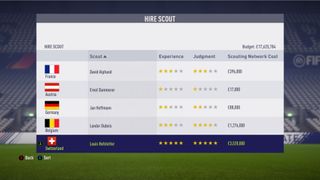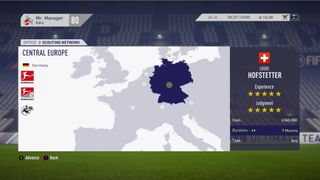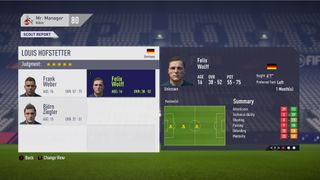Use the scouting system to find your next superstars

One of the best ways to build your team up into a squad of world-beaters and secure your legacy at the same time is by using the scouting system. For a minimal outlay you could find the next Cristiano Ronaldo to lead you on to glory, all for a fraction of the amount it would cost to get the real thing.
But how do you know where you should start looking for these diamonds in the rough? How do you know if you have a huge prospect on your hands, or just an overhyped flop? And can you really scout quality players at a poverty stricken lower league team? Read on for the answers.
Picking the right scout: experience vs judgment

Naturally, better scouts are more likely to find you better players. That’s not to say the worst scouts won’t find good players, but they’re much less likely to. So if you’re serious about scouting, you should hire the best scouts you can afford to. Scouts come with two ratings: one in experience, and one in judgment. But what do these ratings mean?
Experience relates to whether the scout is able to find the type of players that you want them to. If you want to find an exciting young winger, it won’t help much if your scout brings back a load of centre backs. Get a scout with a five-star rating for experience, and that shouldn’t happen.
Specifically, that five-star scout has a solid 80% chance of finding the type of player you’re after. A one-star scout has a mere 30% chance of snagging the right player type, meaning you’ll waste more time churning through irrelevant players on your scout’s reports.
As well as that, experience determines how many players you’re likely to get on each report. The best scouts will suggest between five and seven players to you, meaning there’s a good chance that a highly promising player is nestling among them. A one-star scout will only show you one to two players each time. Combine that with their low chance of finding the right type of player and you’ll really struggle to scout high quality prospects.
Judgment, on the other hand, is all about quality. Can your scout tell the difference between a flash in the pan and the real deal? If they’ve got a high rating for judgment, they’ll be much more likely to find high potential, high quality players to fill your academy with.
The most promising scouted players – those with potential between 75 and 95 – are classed as ‘platinum’ players. Truth be told, there isn’t a huge different here between one-star and five-star scouts. Scouts with five stars for judgment have a 10% chance of finding platinum players, while the lowest-rated scouts have a 1% chance. It’s not an enormous gulf in probability, but still enough to make higher-rated scouts worthwhile.
What’s the best place to send your scouts?

Different nations have different ratings that reflect the likelihood that they’ll produce top scouted talent. Therefore knowing which countries top the list is important so that you don’t waste time (and money) sending your scouts to a low-yield area.
The best two countries to scout in are jointly Brazil and Argentina. Famous for producing some of history’s greatest footballers, it’s no surprise that they’re equally fruitful in FIFA 18. The top five regions to scout are, in order:
• Brazil and Argentina
• Italy, Spain and Portugal
• Central Europe (including Germany, France and Belgium)
• The rest of southern Europe (Croatia, Greece and Turkey)
• The ‘Rest of Europe’ region (such as Czech Republic, Serbia and Romania)
Interestingly, Northern Europe (including the UK, Russia and Scandinavia) doesn’t make it into the top five. No wonder British national teams have performed so disappointingly in recent decades...
What to look for in scouted players

Once you’ve picked a scout and decided where to send them, it’s time to learn what sort of players to look out for. After a month of searching, your scout will bring you a list of names, and it’s up to you to decide who to sign to your academy. How do you know which players are worth it?
Probably the most important thing to consider is the player’s potential range. This will usually say something like 66-80, or 55-75. The player’s true potential – the rating he could possible grow to – lies somewhere in this range.
The best scouted players have a range that tops out at 94. So 75-94 is a lot better than 65-84, for instance. It’s usually a good idea to take the middle number in a range (roughly 85 for a player with 75-94 potential) and compare it to your current squad. If that number is higher than most of your other players’ current abilities, you’ll want to sign that scouted player to your academy.
You should also consider the player’s OVR range, which refers to his overall current ability. The best players will have an OVR range where the lowest number is in the 50s and the highest number is in the 70s. For example, 57-75.
If this range is very low (such as 38-52), the player will have to do a lot of growing to become a useable player in your team. The higher the OVR range the better, as it will take less time before the player is good enough to crack the starting lineup.
Scouting for success

Take all these tips on board and it won’t be long before you’ve found the next generation of superstars for your team. For many teams, scouting is far more financially viable than buying fully developed players, and you get the added satisfaction of watching your raw prospects become the polished gems of world football.
Next: Best buys in FIFA 18’s career mode
Jump to Section:
- FIFA 18 Transfer Negotiation System
- FIFA 18 Scouting System
- FIFA 18 Best Buys

